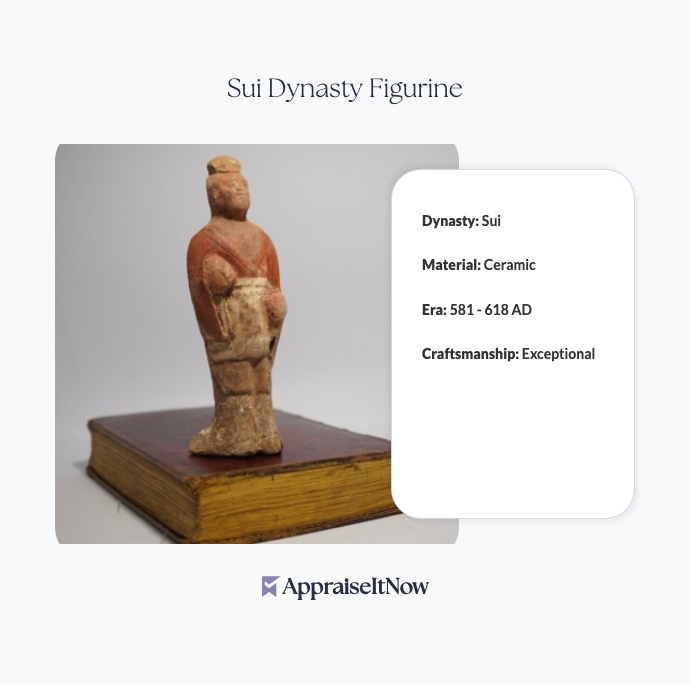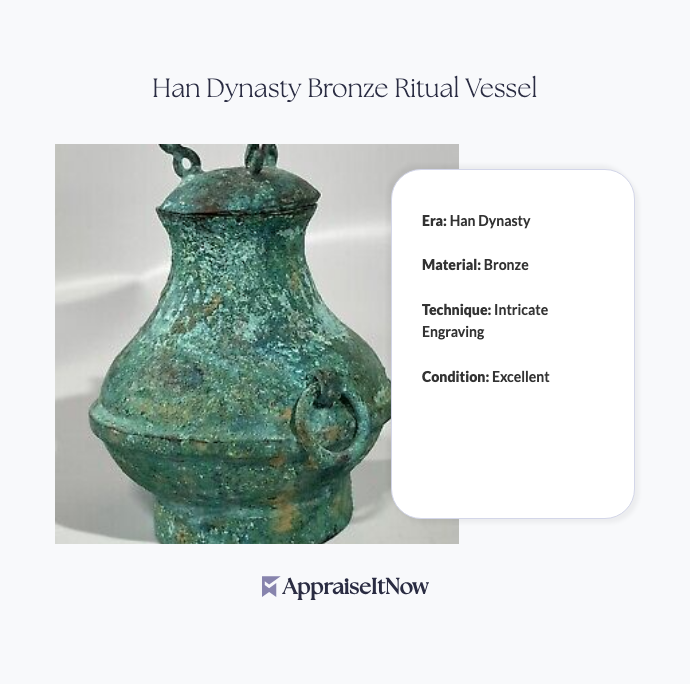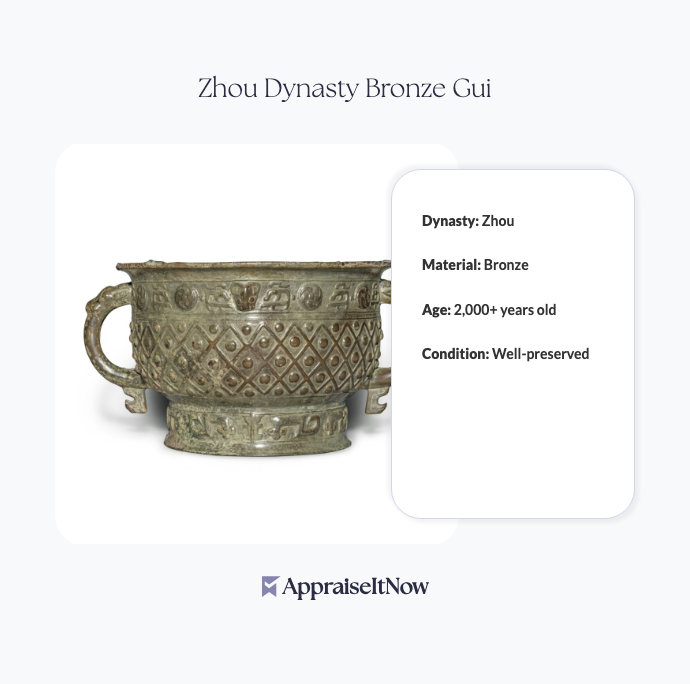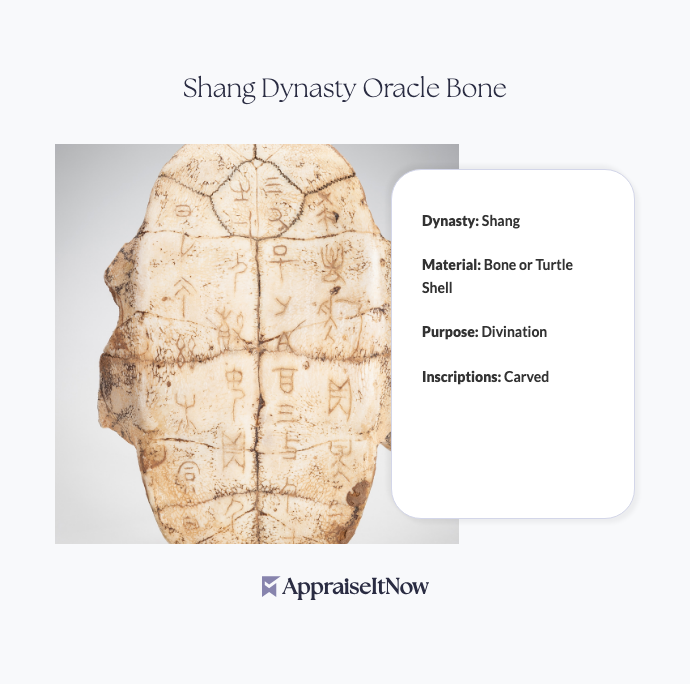<h1>How to Get Your Neolithic Jade Disc Bi Appraised</h1>
<p>If you own or are considering purchasing a Neolithic jade disc bi, understanding its current market value and authentication requirements is essential. These rare ceremonial artifacts from 3000–2000 BCE command prices between <strong>$20,000 and $30,000</strong>, making professional appraisal not just helpful but necessary for proper documentation, insurance, and informed decision-making.</p>
<h2>What is a Jade Bi Disc?</h2>
<p>A jade bi disc is an ancient circular artifact with a centered hole, typically crafted from high-quality jade. What does bi disc mean? The term "bi" refers to this distinctive ceremonial disc form, which held profound spiritual and social significance in Neolithic Chinese societies. These weren't mere decorative objects—they were symbols of power, status, and spiritual authority, often buried with the deceased or displayed during important rituals.</p>
<p>The craftsmanship involved in creating a bi disc was extraordinary. Without modern tools, artisans used stone and jade grinding implements to achieve the smooth, polished finish that distinguishes authentic pieces. This level of intricacy explains why collectors and institutions actively seek these pieces today, particularly when verifying authenticity through professional <a href="/types/artwork">artwork appraisals</a>.</p>
<div class="callout tip"><p><strong>Historical Context</strong></p>
<p>Neolithic jade discs were among the earliest forms of worked jade in East Asian cultures, predating many other known jade applications by centuries.</p></div>
<h2>Understanding Current Market Value</h2>
<p>The estimated market price of <strong>$20,000 to $30,000</strong> reflects multiple converging factors. Rarity stands foremost—genuine Neolithic jade bi discs are uncommon in private collections and institutions worldwide. The cultural importance assigned by museums and serious collectors drives sustained demand, even as supply remains constrained.</p>
<p>Are jade carvings worth anything? Absolutely. Authentic Neolithic jade work represents some of the earliest sophisticated craftsmanship in human civilization. What makes your bi disc valuable depends heavily on condition, provenance, jade quality, and design complexity. Pieces with documented acquisition histories and clear provenance command premium prices within that $20,000–$30,000 range, while examples lacking clear origin may appraise at the lower end.</p>
<p>The rarity of blue jade deserves particular attention. While various jade colors exist—including green, white, and nephrite—blue jade remains exceptionally uncommon, especially in pre-historic examples. If your bi disc features blue jade coloring, this characteristic alone can significantly impact its final appraisal value.</p>
<h2>Authentication: Separating Genuine from Reproduction</h2>
<p>How to tell if carved jade is real represents one of the most critical questions for potential buyers or current owners. Genuine Neolithic jade bi discs display specific characteristics that distinguish them from modern reproductions or later period pieces. </p>
<p><strong>Key authentication markers include:</strong></p>
<p>The material itself should show appropriate wear patterns consistent with age. Authentic jade develops a subtle patina over millennia, which experienced appraisers recognize immediately. The tool marks visible on genuine bi discs reflect Neolithic technology—specific grinding patterns that differ markedly from modern carving techniques. Additionally, the hole at the center should exhibit wear consistent with ancient drilling methods using primitive tools, creating slightly irregular edges rather than perfectly uniform modern precision.</p>
<p>How to test jade with light provides another useful authentication technique. When held to strong light, genuine jade typically displays translucency in thin areas, revealing the stone's internal structure. Reproductions often appear either completely opaque or artificially clear, depending on material substitution. Professional appraisers use specialized lighting and magnification to examine these details, identifying jade type and confirming age-appropriate characteristics.</p>
<h2>Jade Quality and Type Assessment</h2>
<p>What type of jade is most valuable? Understanding jade composition directly affects appraisal. Two primary jade minerals exist—jadeite and nephrite. Jadeite, prized for its vibrancy and durability, generally commands higher values than nephrite. However, Neolithic artisans primarily worked with nephrite jade, which they accessed through local sources. This historical accuracy actually validates authenticity—finding jadeite in a purportedly Neolithic piece should raise red flags.</p>
<p>How can you tell if jadeite is vintage versus modern? Vintage jadeite exhibits specific aging characteristics including surface micro-cracks, subtle color shifts, and patina development. Modern jadeite appears uniformly fresh, with sharp edges and consistent coloration throughout. Professional appraisers compare your piece against authenticated examples, establishing whether the jade aging pattern aligns with genuine Neolithic specimens.</p>
<p>What does the highest quality jade look like? Premium jade displays translucency without excessive cloudiness, consistent coloration, and fine texture without visible pores or blemishes. In a bi disc context, the carving quality matters equally—symmetry, smooth transitions, and balanced proportions indicate skilled craftsmanship. Pieces with natural flaws (common in ancient work) that were incorporated into the design show greater authenticity than perfectly flawless examples, which suggest modern creation.</p>
<div class="callout note"><p><strong>Appraisal Insight</strong></p>
<p>Jade evaluation requires both geological expertise and historical knowledge—reasons why general antique appraisers may lack sufficient specialization for valuable pieces.</p></div>
<h2>The Importance of Provenance Documentation</h2>
<p>Documentation tracing your bi disc's ownership history significantly impacts appraisal value. Does jade have any resale value? Yes, substantially—but verified provenance multiplies that value. Pieces with clear acquisition records, museum exhibition history, or scholarly attribution command substantial premiums over those lacking origin documentation.</p>
<p>When compiling your piece's provenance, gather any available information: purchase receipts, auction house documentation, previous owner records, exhibition catalogs, or scholarly publications featuring your specific object. This documentation becomes invaluable during the appraisal process, as it supports authenticity claims and historical context. Museums often maintain detailed records of acquired pieces; if your bi disc previously belonged to an institutional collection, requesting that documentation dramatically strengthens your appraisal position.</p>
<h2>How to Get Your Bi Disc Appraised</h2>
<p>Professional appraisal services specializing in <a href="/types/antiques">antiques</a> and <a href="/blog/appraising-asian-art-and-antiques-understanding-cultural-significance-and-value">Asian art and antiques</a> understand the specific requirements for Neolithic jade evaluation. When selecting an appraiser, verify credentials including membership in professional organizations such as the American Society of Appraisers (ASA), International Society of Appraisers (ISA), or specialty groups focused on East Asian artifacts.</p>
<p>The appraisal process typically begins with detailed photographic documentation, capturing the bi disc from multiple angles under controlled lighting. Professional appraisers examine both surfaces, the central hole, and any edge characteristics using magnification and specialized tools. They assess jade composition, carving technique, condition issues, and historical context. The final appraisal report provides detailed description, condition assessment, market analysis comparing recent sales of similar pieces, and a concluded fair market value statement suitable for insurance, sale, or estate purposes.</p>
<div class="callout tip"><p><strong>Professional Standard</strong></p>
<p>Look for appraisers providing USPAP-compliant reports—the Uniform Standards of Professional Appraisal Practice ensures your appraisal meets legal and institutional requirements.</p></div>
<h2>Special Considerations for Neolithic Jade Artifacts</h2>
<p>Evaluating cultural significance extends beyond monetary value. How to tell antique jade from reproduction requires understanding not just material science but archaeological knowledge. Neolithic bi discs carry cultural heritage importance that affects both their ethical positioning and market value. Museums increasingly focus on repatriation and cultural stewardship, which may influence availability and desirability within serious collector communities.</p>
<p>The spiritual and ritual context of these pieces deserves recognition. Museums and collectors understand that Neolithic jade discs represented profound cultural achievements—symbols of cosmological understanding and social organization. This cultural dimension attracts scholars, institutions, and ethically-minded collectors willing to pay premium prices for well-documented, properly-preserved examples. Your piece's value reflects not just market demand but collective appreciation for humanity's early artistic and technical accomplishments.</p>
<h2>Market Trends and Future Considerations</h2>
<p>The market for Neolithic jade artifacts demonstrates consistent strength, particularly as Asian art collecting gains prominence among international collectors and institutions. What's the price of jade right now reflects both current material costs and historical artifact premiums. Investment-minded collectors view authenticated Neolithic pieces as alternative assets combining aesthetic appreciation, cultural significance, and potential appreciation.</p>
<p>Recent institutional acquisitions and major auction results have validated the $20,000–$30,000 price range for quality Neolithic bi discs. As wealth accumulation continues globally and collectors increasingly seek alternative investments beyond traditional equities, demand for rare cultural artifacts remains robust. How rare is blue jade in Neolithic contexts? Extremely rare—making blue jade bi discs particularly attractive to serious collectors and museums building representative collections.</p>
<p>Professional appraisal documentation becomes increasingly valuable in this context. Should you decide to sell, donate to an institution, or leverage your piece for estate planning, a certified appraisal provides the authentication and valuation support that serious buyers and institutions require. Similarly, insurance coverage depends entirely on proper documentation—your policy's coverage limit should reflect an accurate, professional appraisal rather than estimates or guesswork.</p>
<div class="callout note"><p><strong>Key Takeaway</strong></p>
<p>A professional appraisal of your Neolithic jade disc bi provides essential authentication, accurate market valuation, and documentation supporting insurance coverage, informed selling decisions, or institutional donation. Given the $20,000–$30,000 market value and cultural significance of these rare artifacts, expert evaluation ensures you understand both your piece's historical importance and its worth in today's collector market.</p></div>
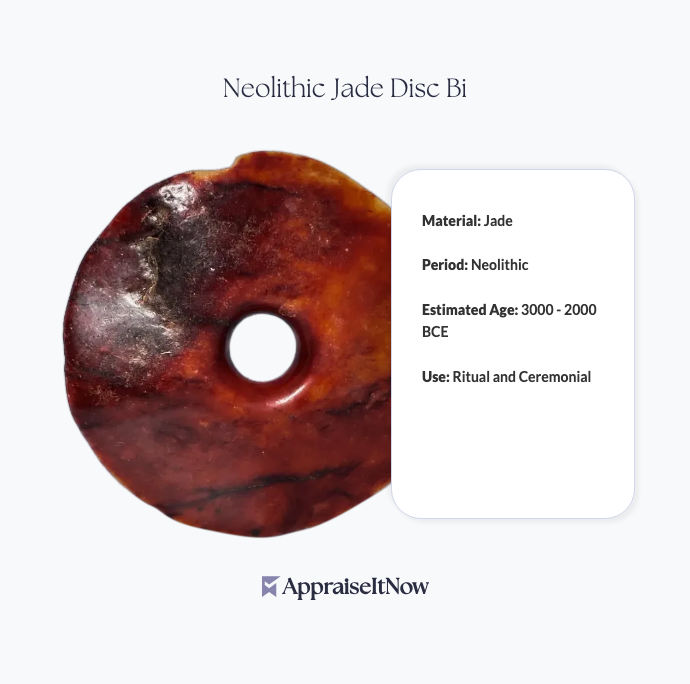






.avif)




